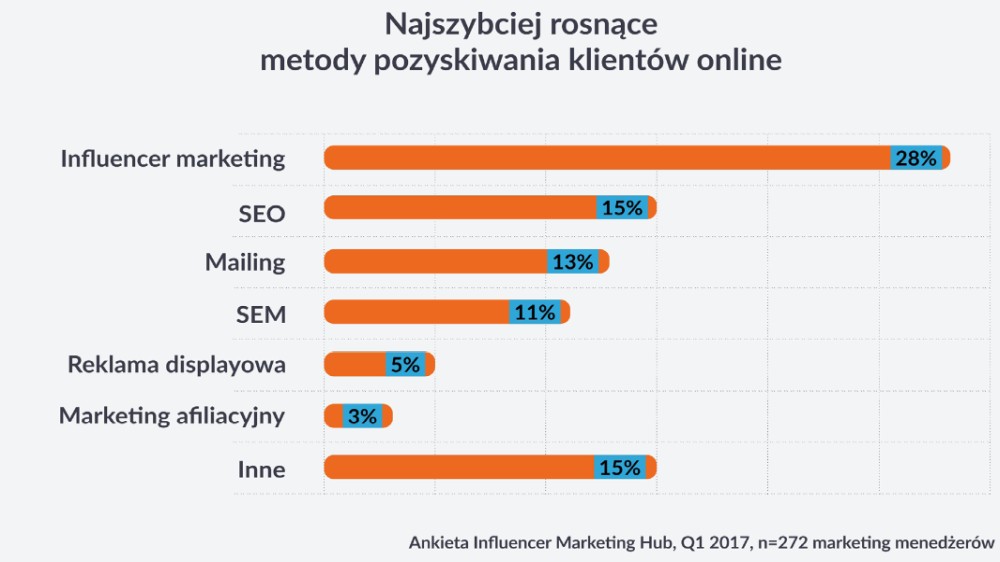 source: Analytics and Influencer Monitoring, Newspoint, December 2017
source: Analytics and Influencer Monitoring, Newspoint, December 2017Four in ten people now have a social media account. Any internet user with a social media profile or blog can be an influencer, shaping what their audience thinks and likes. Since, as Newspoint’s cited studies show, over 70% of consumers consider influencer content to be their primary product information source, it’s no wonder the advertising industry has embraced them.
Influencer marketing, as the report highlights, is the fastest-growing method of customer acquisition today, far outpacing SEO, email marketing, and paid advertising.
- The internet today is largely made up of user-generated content, which is crucial for brands. Sixty-five percent of internet users consider the opinions of other users very important in their purchase decisions - comments Robert Stalmach, CEO of Newspoint, in the report. - This shift changes how brands communicate with their audiences. Users are less receptive to brand information and more inclined to follow suggestions from people they trust.
Why does influencer marketing work? According to the "Analytics and Influencer Monitoring" report, influencers create three times as much engaging content as non-influencers, and each piece of their content is four times more likely to impact the purchase decisions of their followers. The benefits companies can gain from working with opinion leaders include:
- Influencers reach a precisely targeted audience, lowering the cost of reaching potential customers,
- Influencers appear more authentic and credible than intrusive advertising,
- Influencer content is resistant to AdBlock programs,
- Influencer content has the potential to spread virally,
- Influencers may offer fresh, unique perspectives on a product.
However, working with influencers doesn’t automatically guarantee success. This approach also requires a well-thought-out strategy.
- Choosing the right creators for a campaign is challenging, especially with the awareness that their statistics are often inflated (e.g., through comment and visit exchanges, bots auto-liking other Instagram profiles, or “traffic exchange systems”). Not to mention the entire category of “fake-celebrities” who are entirely artificial - explains Kamil Mirowski, Creative Marketing Consultant at 1000ideas and MrSocial.pl, in the Newspoint report. - That’s why it’s so important to verify creators for authenticity (no brand wants to be associated with fraudsters) and for reach and engagement within the target group (let’s face it – we want to reach as many potential clients as possible, not random people).
Despite these caveats and risks, brands are increasingly turning to influencers, and this trend is expected to grow rapidly. Analysts predict that by 2020, influencer marketing will be worth $10 billion.
The complete "Analytics and Influencer Monitoring" report can be downloaded on the Newspoint website.
COMMERCIAL BREAK
New articles in section Marketing and PR
Dance in the media mirror. Between culture, business and viral fame
KFi
Over 78,000 media pieces, 1.6 billion potential views, and 197,500 social media mentions-dance in Poland is no longer niche. With a combined media value exceeding PLN 800 million, it now outperforms MMA, handball, and hockey.
PR in Poland. Ranking of the largest public relations agencies 2025
KFi
The smallest teams often generate the most publications, and agencies outside Warsaw are increasingly capturing media attention. This unexpected distribution of power is one of the key findings from the 2025 PR Agency Ranking in Poland, developed by Widoczni and IMM.
Connected TV and borderless advertising. The ID5 report
KFi
Viewers are moving away from cable TV. And they are doing it en masse. Already 86% of Europeans watch content via Connected TV and global ad spend in this segment is set to double by 2028. The industry is undergoing a communication revolution.
See articles on a similar topic:
Rising Google Ads click costs. How to keep campaigns profitable?
Patrycja Kranc
In 2024 the average cost per click (CPC) rose in 86% of industries. In e-commerce and real estate, increases reached dozens of percent. Optimisation is becoming crucial, not only for campaigns but for the entire customer acquisition process.
More AI bots in customer service. However, Poles want people
Andrzej Sowula
Over three quarters of Poles (75.9%) have already had contact with a bot in a customer service department and nearly one in four is satisfied with this service. This means an increase of 7.7% over the past two years. At the same time, only 8.1% of Poles fully trust the bots serving them.
Bots on Hotlines. Armatis Customer Experience Index Study
KF
Nearly two-thirds of Poles report encountering a chatbot or voice bot when contacting customer service. This type of service often triggers negative emotions. Almost three-quarters of Poles would prefer to wait in line for human assistance rather than be served immediately by a bot.
Online advertising 2024/2025 report by IAB Poland
KFi
Online ads now consume 57% of all budgets. Companies spent 1.62 billion PLN on video formats alone. After leaner years, the numbers are rising sharply. Digital advertising grew by 20% in a year. Traditional formats are slowly fading.





























